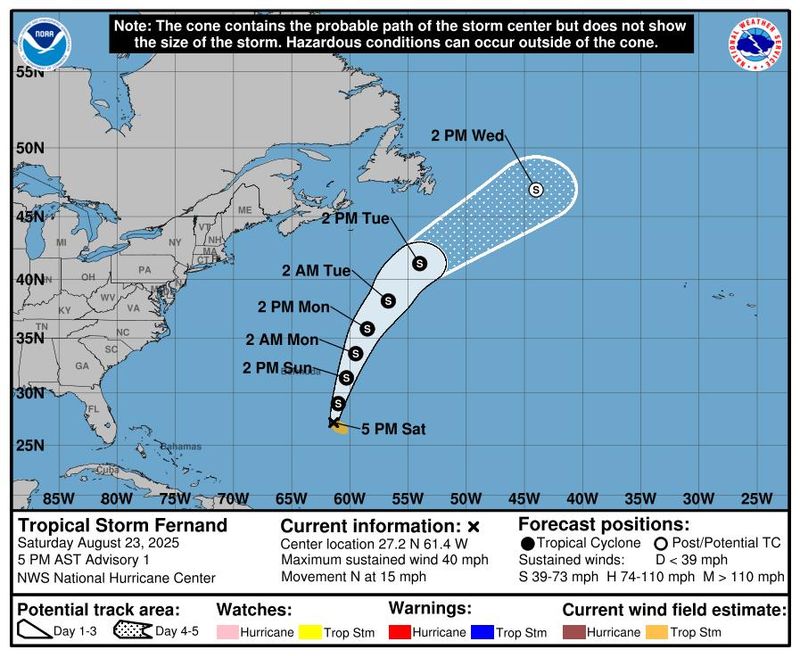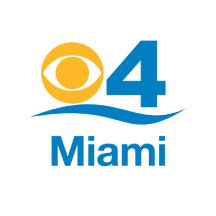
Tropical Storm Fernand has formed in the Atlantic, making it the sixth named storm of the Atlantic hurricane season.
Fernand, which became a tropical storm on Saturday, Aug. 23, was trotting north in the southwestern Atlantic. The storm was expected to "move well east of Bermuda and across the open waters of the subtropical North Atlantic," the National Hurricane Center said.
The news comes days after Hurricane Erin strengthened into a monster Category 5 storm, churning up the ocean along the East Coast, leading to eroded beaches and coastal flooding. While Fernand is expected to intensify as it moves northward, possibly even becoming a hurricane at some point, impacts to the United States aren't likely to be as significant, according to AccuWeather.
Forecasters have been watching the system for days and have said they don't expect any major impact on the United States mainland.
"At this time, direct wind and rain impacts are not expected in the U.S.," AccuWeather's lead hurricane expert, Alex DaSilva said previously, "but rip currents and rough surf could impact some East Coast beaches again next week.”
In Morehead City, on North Carolina's Outer Banks, where clean-up and recovery efforts continue after Hurricane Erin, Fernand isn't expected to create any swells affecting the area, said weather service meteorologist Ryan Fucheck. "Right now we are not anticipating any long-distance swells from Fernand to impact the coast," Fucheck told USA TODAY on Aug. 23. "Given the small nature of the system and relatively quicker northward movement over the next few days, any swells from Fernand would stay relegated near the storm."
Fer-what?
If you want to flash your hurricane savvy, be sure to pronounce it right.
Seeing the name Fernand might make readers wonder if we’ve left off the O. After all, Fernando is a more familiar version of the name, especially given the number of popular athletes known as Fernando, including Fernando Valenzuela, nicknamed "el Toro," the late Dodgers pitching legend, Fernando Alonso, the Spanish Formula One racing driver and several well-known soccer players.
But the storm is really named Fernand, and it’s pronounced “Fair – NAHN,” according to the World Meteorological Organization committee, the group that chose the name to be included in the six-year rotation of storm names.
Have there been any famous Fernands? Yes. Fernand Léger was the famous 20th-century artist whose works personalized Cubism. Fernand Point was a French chef now considered by many to be the father of modern French cuisine.
The next name up for the seventh named storm is Gabrielle, “ga-bree-ELL.”
Who names hurricanes?
A committee from the World Meteorological Organization is responsible for maintaining the list of 21 names for each hurricane season for each tropical cyclone basin around the world, including the Atlantic and the Eastern Pacific. The names are prepared far in advance and appear on a six-year rotating list until a storm leaves such a swath of damage and destruction that it's retired from the rotation.
The list includes only 21 letters because it's difficult to find names to match the letters Q, U, X, Y and Z, according to the WMO. In the Atlantic basin, English, French and Spanish names are used in the list to reflect the geographic locations where storms may travel.
The committee also publishes a list of how to pronounce the names, with an eye to avoiding confusion. Some names, however, defy even the best intentions.
What does the rest of hurricane season hold?
Fernand’s formation means the Atlantic hurricane season is making good on early season forecasts that it would be more active than normal. Typically, the sixth named storm would appear by Aug. 29, according to the National Hurricane Center.
Seasonal forecasters for the National Oceanic and Atmospheric Administration said in August they still expect a range of 13 to 18 total named storms (winds of 39 mph or higher). Of those, five to nine are forecast to become hurricanes (winds of 74 mph or higher).
“The heart of hurricane season is starting to heat up," DaSilva noted. The Atlantic hurricane season is expected to peak around Sept. 10. "We expect the second half of the hurricane season to be more active than the first half.”
The normal seasonal activity for the 30 years from 1991 to 2020 included 14 named storms, seven hurricanes and three major hurricanes with winds of 111 mph or more.
While NOAA's long-term tropical outlook keeps things relatively low key between Aug. 27 and Sept. 2, with a potential for development in the far eastern Atlantic, the forecast for the first full week of September shows the potential for tropical activity in the main hurricane development region, and in the southern Gulf and western Caribbean.
Tropical Storm Fernand path tracker
This forecast track shows the most likely path of the center of the storm. It does not illustrate the full width of the storm or its impacts, and the center of the storm is likely to travel outside the cone up to 33% of the time.
How do hurricanes form?
Hurricanes are born in the tropics, above warm water. Clusters of thunderstorms can develop over the ocean when water temperatures exceed 80 degrees Fahrenheit. If conditions are right, the clusters swirl into a storm known as a tropical wave or tropical depression.
A tropical depression becomes a named tropical storm once its sustained wind speeds reach 39 miles per hour. When its winds reach 74 mph, the storm officially becomes a hurricane.
Prepare now for hurricanes
Delaying potentially life-saving preparations could mean waiting until it’s too late. "Get your disaster supplies while the shelves are still stocked, and get that insurance checkup early, as flood insurance requires a 30-day waiting period," NOAA recommends.
- Develop an evacuation plan: If you are at risk from hurricanes, you need an evacuation plan. Now is the time to begin planning where you would go and how you would get there.
- Assemble disaster supplies: Whether you’re evacuating or sheltering-in-place, you’re going to need supplies not just to get through the storm but for the potentially lengthy aftermath, NOAA said.
- Get an insurance checkup and document your possessions: Contact your insurance company or agent now and ask for an insurance check-up to make sure you have enough insurance to repair or even replace your home and/or belongings. Remember, home and renters insurance doesn’t cover flooding, so you’ll need a separate policy for it. Flood insurance is available through your company, agent, or the National Flood Insurance Program. Act now, as flood insurance requires a 30-day waiting period.
- Create a family communication plan: NOAA said to take the time now to write down your hurricane plan and share it with your family. Determine family meeting places, and make sure to include an out-of-town location in case of evacuation.
- Strengthen your home: Now is the time to improve your home’s ability to withstand hurricane impacts. Trim trees; install storm shutters, accordion shutters, and/or impact glass; seal outside wall openings.
This article originally appeared on USA TODAY: Tropical Storm Fernand forms in the Atlantic. See its projected path.
Reporting by Phaedra Trethan, Jeanine Santucci and Dinah Voyles Pulver, USA TODAY / USA TODAY
USA TODAY Network via Reuters Connect

 USA TODAY National
USA TODAY National
 The News-Star
The News-Star SouthCoastToday
SouthCoastToday CBS4 Miami
CBS4 Miami FOX Weather
FOX Weather Newsday
Newsday WITN-TV
WITN-TV Las Vegas Review-Journal Politics
Las Vegas Review-Journal Politics The Daily Bonnet
The Daily Bonnet AlterNet
AlterNet Battle Creek Enquirer Sports
Battle Creek Enquirer Sports The Babylon Bee
The Babylon Bee